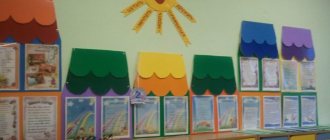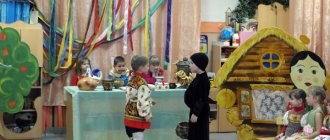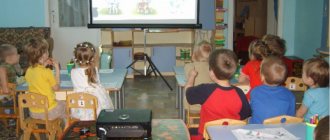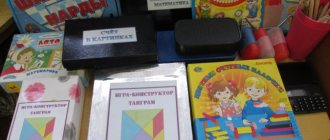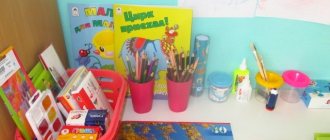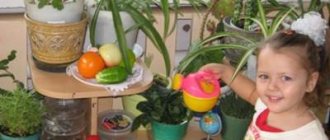Environmental corner in kindergarten. Decor
Decorating an ecological corner in a preschool educational institution with your own hands
Author:
Natalya Yakovlevna Kress, teacher of the Bolsheplotavsky kindergarten, Bolshie Ploty village, Efremovsky district, Tula region. This work is intended for preschool teachers. I want to share my experience of designing an ecological corner. For many years I have been working in a multi-age kindergarten group, where children from 3 to 7 years old are raised, so in the environmental corner I have collected materials that take into account the age of children 3-7 years old. In the group room I built a “mushroom” - a cabinet with manuals. As a mushroom stem I used a small cabinet with shelves, which I covered with self-adhesive film. And I made the hat out of cardboard. She also became a shelf.
In this improvised “mushroom” I placed materials to introduce children to the natural world. Here you can find educational material, children's books about nature, homemade books, seeds and fruits of plants, and herbariums. In the ecological corner there is a book “Indoor Plants”, which we made together with the children. It contains information about indoor plants located in the group room. Each plant is dedicated to one “leaf”, which contains a photograph of the plant and its name, and on the reverse side its description. In the corner, children of senior preschool age can get acquainted with the caterpillar, which will “tell” about the twelve months of the year.
Also in the corner there is a folder with herbariums that we made together with the children. It contains samples of plants from our native village.
All indoor plants were marked with colored circles. I made lists of indoor plants for our group room with labels on separate stands.
On the stump the mole gardener has everything he needs to care for indoor plants.
General view of the ecological corner.
Having such a corner in a group room is very convenient. Didactic material for organizing educational activities or individual work with children is always nearby, at hand. And children can independently look at the pictures and books they like, and play with wild and domestic animals.
We recommend watching:
Mini-museums in my kindergarten group Making a curtain clip with your own hands Organizing play activities in a mixed-age group Organizing play activities in a mixed-age group
Similar articles:
Do-it-yourself group decoration in kindergarten
DIY Autumn panel
Decorating a corner of nature in the second junior group
Elena Korshunova
Decorating a corner of nature in the second junior group
Decorating a corner of nature in the second junior group
Korshunova Elena Valerievna
“Nature has taken care of everything so much that everywhere you find something to learn”
Leonardo da Vinci.
Children's knowledge about nature at the age of 3-4 years expands significantly: there is a more complete acquaintance with objects and phenomena of inanimate nature, seasonal changes, the animal and plant world. Children learn the division of animals into domestic and wild and the corresponding differences in their lifestyle and habitat. More extensive information about birds (migratory and wintering) is given, the concept of insects (ants, butterflies) and other representatives of the animal world (lizard, turtle, frog) is formed.
The understanding of the plant world is also enriched: children learn the concepts of “grass”, “tree”, “flower” and learn to distinguish them by external signs. A primary understanding of the needs of living organisms for food, water, heat, and human labor in caring for animals and plants is formed. Children begin to show feelings for objects of nature, animals, plants, and express elementary value judgments about its phenomena: “I like the dog, she guards the house. I don’t like it when it’s raining and cold.” There is an interest in experimenting with water and sand.
All this is reflected in the fullness of our corner of nature, where not only ready-made purchased materials are presented, but also homemade manuals created together with the parents of the group.
"Green Corner"
1. Represented by Houseplants. Large leaves are suitable for learning how to independently care for the plant (cleansing dust). Children can water their own plants. Also included are passports for the care and characteristics of the plant.
2. In the corner there are plants characteristic of different seasons:
— Autumn — an exhibition of vegetables, crafts made from leaves and natural materials;
— Winter — branches of coniferous trees;
- Spring - vegetable garden, planting onions, peas for observations;
— Summer — bouquets of their ornamental plants.
3. Equipment for caring for plants: watering cans, spatulas, rags, rakes, aprons, sticks for loosening.
"Natural material"
in containers: sand, pebbles of different sizes, shells, fruits and seeds of plants, feathers, millet, rice, buckwheat, pine cones, dry plants, HERBARIUM.
"Center of Water and Sand"
1. Plastic containers for water and sand, aprons;
2. Card index of games with water and sand;
3. Natural material;
4. Containers of various capacities, a sand mill, spoons, spatulas, rakes, all kinds of molds, stamps for printing footprints in the sand, sticks, a sieve, small toys for burying and finding, vessels for pouring, floating toys;
5. Magnifier.
"Nature Calendar"
The calendar was made by the student’s mother, as work is being done to establish relationships with parents and actively involve them in the life of the group.
The nature calendar consists of several pages: season, time of day, natural phenomena, doll with clothes for different seasons. Everything is done with Velcro, so children can independently change the nature calendar, as well as develop fine motor skills.
"Moving folder"
The folder contains all the necessary thematic material needed for classes, observations, free and individual activities: riddles, poems, games, coloring pages, cut-out pictures, consultations with parents, posters, and so on.
"Didactic games"
Didactic games are represented by both purchased board games and games created independently and with the involvement of parents: find vegetables and fruits by seeds and seeds, find my shadow, the third odd one, lay it out along the contour. The games “Find My Shadow” and some others can be used repeatedly by using Igrovisor V. Voskobovich.
"Leapbook on ecology"
The laptop contains all the necessary material on ecology: what not to do in nature, prohibitory signs, experiments, environmental tales and games, living and inanimate nature, a maze game, and a waste sorting game.
“Subject and subject pictures”
Children get acquainted with the features of the appearance and lifestyle of fish, insects, and amphibians. There is also a card index of pictures of trees, plants, shrubs, vegetables, fruits and other topics. For free viewing, children are offered sets of toys depicting animals and their young, as well as inhabitants of various ecological systems (ponds, forests).
Corner “Eco-preschool children”
Elena Gorbunova
Corner “Eco-preschool children”
" Ecolyats - young conservationists"
in preschool educational organizations
For the purpose of environmental education , environmental culture and education of preschool children, in MDOU d/s No. 5 “Zvezdochka”
, the city of Furmanov, Ivanovo region, several years ago, a creative group of teachers created
“
Eco-preschool children ” Corner .
The corner is one of the places in the preschool educational institution where our students can observe and experiment. Here they have the opportunity to maximize their curiosity, activity and independence.
There is a logo " Ekolyata " in
, nearby are the Hymn
of the Ecolyats and the Oath of the Ecolyats .
Certificate " Ekolyat-preschool children "
can be received by every preschool child who takes an active part in environmental campaigns, events and projects of the preschool educational institution.
Photos of environmental actions and environmental holidays , quizzes and other events according to the Environmental Calendar are located in the “Eco-Diary”
and at the
“Environmental Projects”
(
“Let’s collect paper and save wood!”
,
“Take care of the Christmas trees
,
“Feeder for the little bird
,
“Earth Day”
and others).
Next to the Stands, in the Corner , there are fairy-tale inhabitants - heroes of the ABC of Nature-Love: Naughty, Clever, Herringbone and Quiet, who help to form an ecological culture and a culture of Nature-love in students. And also in a playful way they solve the problems facing educators who introduce children to nature: the formation of an elementary system of knowledge about nature, the formation of labor skills and abilities, and love for nature.
Hero-Ecolyats are presented in two versions: some are small in size, located in different sectors of the Corner (for example, Naughty loves flowers, so he is in the sector of indoor plants, others are tall, which are intended for working with preschoolers outside the Corner (on the Ecological Trail , on area and in group premises of preschool educational institutions).
Our Corner is divided into several sectors:
Eco-vernissage, where children’s works are displayed, in accordance with the Ecological calendar and comprehensive thematic planning of the kindergarten (drawings, crafts made from natural or waste materials can be located here).
In the indoor plant sector, children get acquainted with the variety of indoor plants and learn basic care for them: watering, cleaning dust, loosening the soil.
In the garden"
In the autumn-winter period, onions, seedlings of vegetables and flowers grow.
To care for indoor plants, there are brushes , watering cans, rakes, and a spray bottle in the corner.
In the experimental activities sector, a mini-laboratory has been created, classes in which contribute to the development of cognitive interest in children, increase interest in research activities and contribute to the formation of the foundations of a scientific worldview.
In the collecting sector, children enjoy playing with collection exhibits, examining them, classifying them, and enriching their knowledge (collections of buttons, stones, shells, flying seeds, fabrics, paper, and others).
The most favorite place for the children is the “Living Corner ”
.
The inhabitants of the living area can be : fish, turtle, hamsters, parrots. The children enjoy watching them and participating in feeding.
Also in the Corner there are author’s manuals and games (d/i “The Water Cycle in Nature”
, do-it-yourself fairy tale
“Journey of a Droplet”
, Teaching tree
“Seasons”
, lapbook
“Natural World”
, layouts
“Natural zones”
and others).
The literary sector contains various encyclopedias, works of art about nature, riddles, posters, illustrations depicting animals, birds, insects, fish, and mushrooms. Reference cards for familiarization with natural objects. Discs with cartoons and environmental interactive games), materials for environmental projects , teaching materials and manuals for conducting classes, literature for children and teachers on ecology , didactic games.
